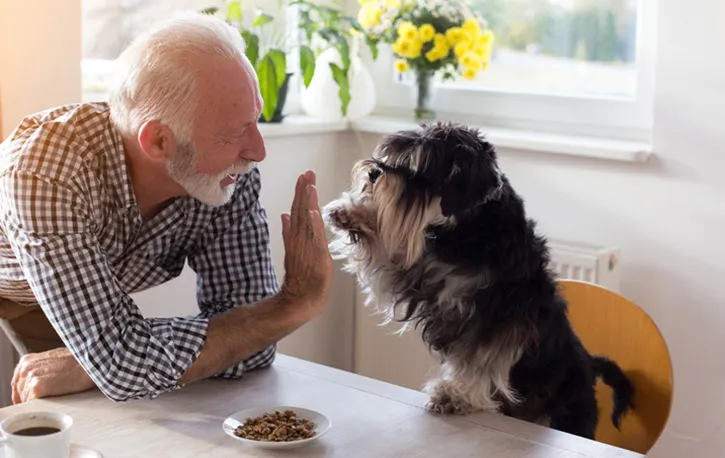Table of Contents
If you have made the big and exciting decision to bring a new dog into your life, you have the option of purchasing a puppy from a breeder or adopting a dog from a shelter or rescue organization. There are so many wonderful dogs in need of safe homes, so providing a loving environment for a homeless pup can be a very rewarding experience. However, bringing home a rescue dog and helping your new pet adjust to daily life can be a significant challenge because of a dog’s past living conditions, health concerns, and behavioral issues.
To guide you through the phases of a rescue dog and work through the rescue dog adjustment period, here is an overview of what to expect after the adoption paperwork is complete and you make your way home together for the first time.
What Is a Rescue Dog?
Rescue dogs are those that have found themselves homeless for one reason or another and are in need of a new place to live. There are many reasons why dogs end up in shelters:
- Sometimes, pet parents surrender their dogs at shelters because they can no longer care for them.
- Other dogs are picked up by animal control off the streets and brought into shelters.
- Puppies can be born at animal shelters after their mother is brought in.
- You’ll also find rescue dogs in shelters that have come from puppy mills, those that are found after natural disasters, and that simply get lost after wandering away from their family homes.
A common misconception is that all rescue dogs have experienced trauma and are “damaged goods.” Although some dogs that end up in shelters had a rough life before they met you, this is not true of all rescue dogs. Unfortunately, some dogs in shelters come from abusive situations and hard lives on the streets fending for themselves. But others have never known life outside of a shelter or have only been in a shelter for a very short amount of time. Oftentimes, these dogs don’t carry the weight of intense trauma and are just as healthy and well-adjusted as a purebred dog that you might buy from a breeder.
Common Issues of Rescue Dogs
Rescue dogs are going through a lot of changes as they make their way from one household to another or from life on the streets to a shelter before coming to your home. They may feel anxious, shy, or even aggressive as they go through these changes and find comfort with you as their new caregiver. Some dogs that have had rough lives in the past may be dealing with trauma and need a period of decompression to accept love and affection again. If a rescue dog has been abandoned, it may have separation anxiety issues and feel unsafe without constant affirmations from trusted people.
Rescue dogs may be overeager to please new people and seem overstimulated, exhibiting behaviors like excessive licking and jumping up on people. Your new rescue dog may have been socialized early on as a puppy or never had the opportunity to develop good social skills well into adulthood. If a rescue dog has not grown up being around children or other pets, it may take the dog some time to adjust to these new situations too.
Phases of a Rescue Dog
Although every dog is unique, there are certain phases that many rescue dogs go through as they transition into their new lives. The first phase is often the honeymoon phase, where everything seems to be going smoothly, and you are surprised at how well the dog is adjusting. On the other hand, some rescue dogs have the complete opposite reaction to a new environment and can be an instant challenge for new pet parents.
Phase two is the rescue dog adjustment period, which is when your dog begins to relax and get comfortable around you. The dog’s personality will start to come out, and you will start noticing certain behaviors and mannerisms that are either positive or negative. The third phase is the settlement period, in which the end result is a dog that feels fully comfortable, safe, and loved in your care.
A common question that new pet parents have is, “How long does it take a rescue dog to adjust to a new home?” It typically takes a few months or even longer for a rescue dog to progress through the adjustment phases and feel totally comfortable in a new environment.
The 3-3-3 Rule
In the realm of dog training, there is the 3-3-3 rule that is often discussed when adopting a rescue dog. The “3s” represent periods of time: three days, three weeks, and three months. The first rescue dog adjustment period takes approximately three days, the second period three weeks, and the third period three months.
During the first three days with your new dog, expect the pup to feel overwhelmed, scared, and unsure about what is going on. These are the days when your new dog may not want to eat or drink, which is typically normal. The new dog may want to test the boundaries of what is allowed in your new home, or he/she may just want to curl up and hide or nap for a while.
After these initial days together, you can expect the dog to start settling in over the next three weeks. Your dog should begin realizing that this could be a forever home and figuring out the environment. This is an important time to start setting good routines and correcting behavioral issues before they become major problems.
During months two and three, after rescuing a dog, you can build up your dog’s trust in you and form a real bond. You should be set in your routine by now and ensure the dog has a sense of security in the new family and home setting. Of course, the 3-3-3 rule is a general guideline, as some rescue pups will progress through the phases faster or slower than others.
Getting Your Home Ready for a Rescue Dog
If you know in advance that you will be bringing home a rescue dog, there are certain things you can do proactively to get your home ready. Just like bringing a new baby home from the hospital, it is important to dog-proof your house to keep your new furry friend safe. This process may include picking electrical cords up off the floor so that they can’t be chewed, placing breakable items up on high shelves, and creating a designated space for your dog to relax and sleep.
Rescue dogs often find comfort in a crate after living in a shelter. Crates are not cruel or constricting for dogs – they are safe and quiet spaces where a rescue dog can decompress and have some time to unwind and process everything that is going on. If you live in a home with a yard, make sure that you have a secure fence so that the dog doesn’t accidentally wander off or be tempted to sneak under or jump over the fence.
Of course, you’ll want to stock up on basic dog necessities too, such as high-quality dog food, bowls for food and water, a dog bed, collar, leash, and ID tag. You may also want to pick up a few dog toys, a ball to play with, and a bone to chew.
Training After Rescuing a Dog
Another important thing to think about when adopting a rescue dog is coming up with a training plan based on the dog’s needs and your own needs too. Research local dog training classes in your area and be knowledgeable about the cost and schedule. Training is important for both a rescue dog and a new pet parent, so be proactive about training rather than waiting for behavioral issues to come up over time.
Reward-based training methods work well for most rescue dogs, rather than leash corrections, shock or prong collars, or other potentially harmful strategies. Some skills to work on together include house training, responding when called, not pulling on the leash, and handling alone time. You’ll also want to work with your rescue dog on not jumping up on people, not being too mouthy, not chewing household items, and not being fearful of other dogs. Patience is very important when training a rescue dog, as well as setting boundaries and showing love and understanding every step of the way.
Other Rescue Dog Considerations
To have the best experience bringing home a rescue dog, you may want to introduce the dog to your yard before bringing the pup indoors. This allows the dog a little time to get used to the new smells and where you would like him/her to go potty.
Outside is also the best place to introduce your new dog to an existing dog already living with you. You can start the introduction by taking them for a walk together and bringing the new dog to the outside of the fence so they can smell each other from a safe distance before being in each other’s space. It is often a good idea to keep old and new dogs separated for at least a day or two to let everyone adjust to the new situation before fully integrating them together in the house.
Make sure that the first few days after adopting a rescue dog are quiet and calm in your house. Don’t overwhelm the new dog with lots of strangers or too many new situations, such as the local dog park or a long road trip just yet. Keep walk times, potty breaks, and feeding times consistent so that your rescue dog knows what to expect as the days go by. If you have kids in the house, avoid leaving the new dog alone with the kids right away. Always supervise children and pets, especially in the early days when behaviors can be unpredictable, and elements of fear and protectiveness can come out unexpectedly.
Pet Insurance for Rescue Dogs
Pet health insurance is a smart idea regardless of whether you purchased your dog from a breeder or adopted a rescue dog. It is especially important for rescues because you often have no way of knowing the genetic history of your dog and or exactly what breed the dog is. Many rescue dogs are mixed breed dogs and resilient animals that live long and healthy lives without major issues. However, a rescue dog may be prone to certain breed-specific and genetic conditions that you aren’t aware of and can’t plan ahead for because of the dog’s background.
Fortunately, Healthy Paws is a pet insurance plan that covers genetic and hereditary conditions and breed-specific conditions in addition to accidents, illnesses, emergency care, and cancer. We offer one simple-to-understand plan that makes it easy to protect your pet and your finances when your dog isn’t feeling well. You can sign up for a dog insurance plan as early as when your puppy is eight weeks old or enroll rescue pups as old as 14 years.
Contact us today for your rescue dog insurance quote and fully commit yourself to improving the life of your new canine companion.







